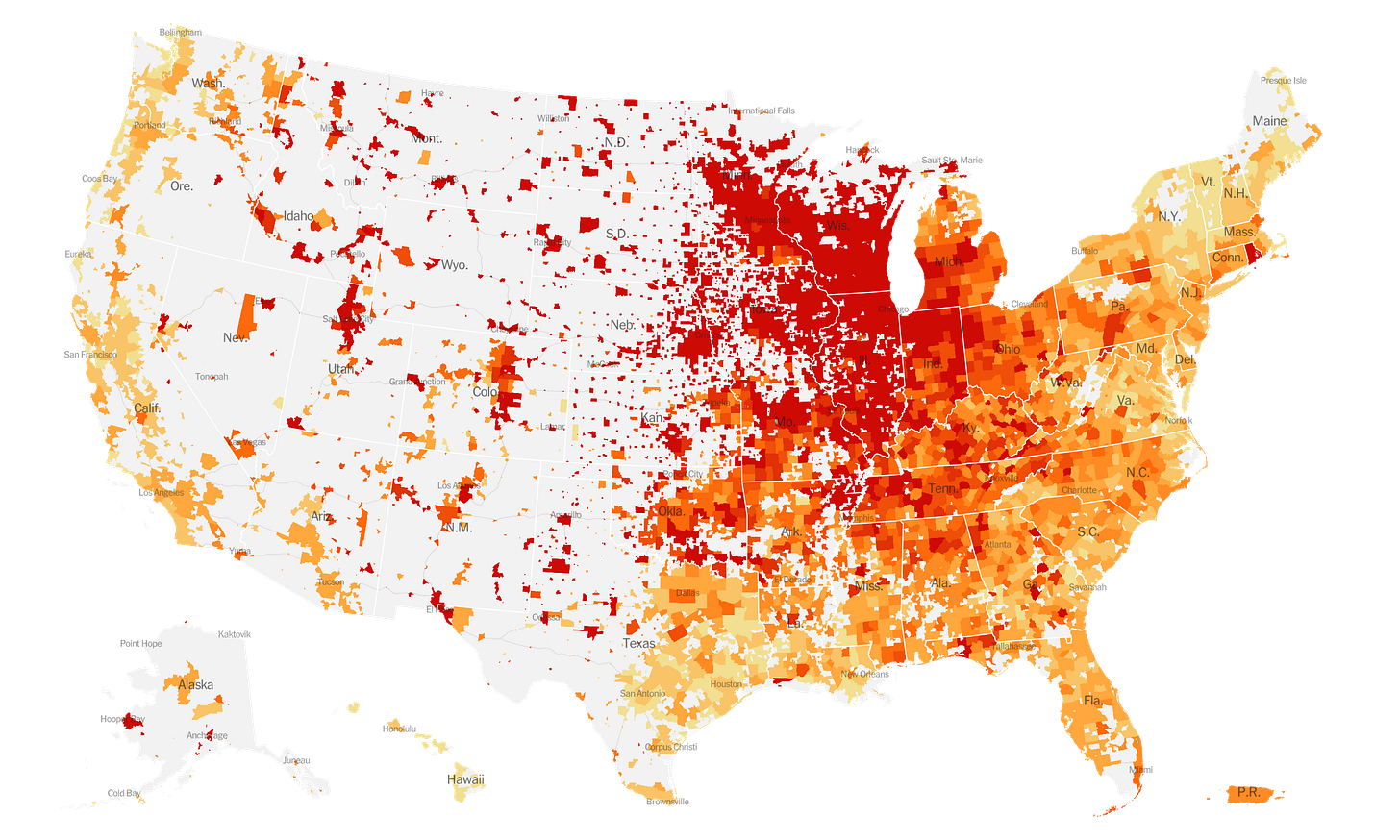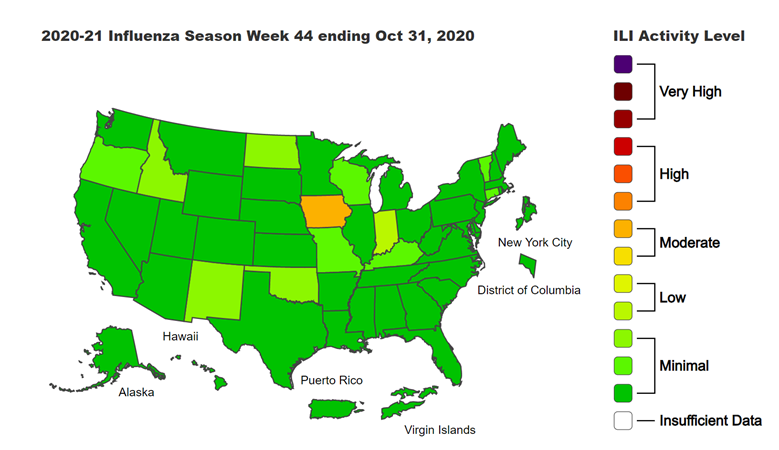The World
Globally, the SARS-CoV-2 virus that causes COVID-19 disease has sickened > 50.7 million people (+4.1 million since last week) and killed 1,260,800 (+59,400 in the past week) as of this morning.
The US is ranked in the top color category for hot spots, where the dark red represents counties with >14 average daily case rate per 100,000 for the past week. Noticeable changes in this week’s global map is that things have intensified in Canada and Russia. The entire European continent is shaded dark red with the exception of Norway, Finland and Belarus. We are ranked 31st in the world for average daily case rate per 100,000 people over the past 7 days (last week, 30th) with a rate of 33.5 compared to 25 last week. So our situation has gotten worse, but our ranking slipped. That tells you that even as things have escalated here, they have escalated even more for other countries. The top five countries for average daily case rate per 100,000 in the past week are Luxembourg, Andorra, Czech Republic, Switzerland and Montenegro.
For deaths, our average daily death rate per 100,000 over the past week is 0.3 and we are ranked #39 in the world for this which is the same as last week, despite last week’s death rate of 0.2. The top five countries for average daily death rate per 100,000 in the most recent week are Czech Republic, Belgium, Slovenia, Bosnia and Herzegovina, and Armenia.
The United States
As hot spots go, they didn’t move that much this week but got more intense, especially in the Midwest. For the South, things got more intense for Tennessee and that is spilling over into neighboring counties in other states. The Mountain West is also seeing increases. As of this morning, there have been over 10.1 million cases and 238,246 deaths in the US. Keep in mind that both of these numbers are probably an under-count of the situation in our country. Note, the New York Times coronavirus tracker *IS* now including the antigen test-identified positives that Georgia DPH reports each Monday in the Daily Situation Report.
Cases: Georgia is ranked #39 in the nation for average daily case rate per 100,000 over the past week, at a rate of 22.8. Last week, we were ranked #37 with a rate of 18. So just like for the US standing in the world, the situation in Georgia has grown more intense but our ranking has slid downward - indicating just how much worse things have become for other states. Of the top 10 states for average daily case rate per 100,000 over the past week, none are in the South.
Georgia has no counties in the top 20 counties in the nation list for cases per 100,000 in the past week. We also don’t have any cities in the top 20 for case rate per population.
Testing: In the past week, Georgia decreased slightly in the rankings from 43rd in the nation (198 tests performed per 100,000 in the past 2 weeks) to 44th, with a testing rate of 194 tests per 100,000. Meanwhile, the national average is 387 tests per 100,000. The Harvard Global Health Institute together with the New York Times, estimates that Georgia is performing at 68% of the ideal testing target which is a big jump in the right direction from how we were performing in the previous week (40%).
Hospitalizations: Georgia is now ranked #23 in the nation (down from #11 last week) for proportion of inpatient beds occupied by COVID patients at 9.4% (down very slightly from 9.7% last week). The top three states and territories in the US for this metric are Guam (19.5%), North Dakota (19.1%), and South Dakota (19.0%). These data come from the Health and Human Services dashboard which was last updated 06Nov2020.
However, if you look at how ICU occupancy is going for the US, here’s what you find. Major swaths of the US have at least 70% of their ICU beds full. The top three states in the nation are Mississippi (88%), Rhode Island (86%), and Alabama (85%). Georgia is ranked #8 in the nation, and we aren’t even experiencing a surge in hospitalizations yet. What’s important to remember about this map is that it’s ICU beds being used for all purposes - it isn’t specific to COVID-19 patients. But those beds are needed for all sorts of reasons many of which are completely unrelated to COVID-19 (i.e. heart attacks, strokes, car accidents, etc). We should remember that our healthcare workers are not an unlimited resource and we shouldn’t want to put them in a position of having to decide who gets care when resources are limited. Please do what you can to limit your transmissions so that we have fewer people needing hospitals and ICU beds.
Deaths: For average daily death rate per 100,000 over the past week, the rate for Georgia is 0.3 and we are ranked #34 for this. Last week, the death rate was 0.2 and we were ranked #33. As for cases, our situation has grown more intense (albeit slightly) and yet our ranking has declined. Things are much worse for the other states in the country and we should do what we can to prevent things from escalating further in Georgia. There are no southern states in the top 10 this week, unless you count Arkansas (#9).
Influenza: Here’s the latest look at FluView, showing how influenza-like illness compares across states. The map below depicts how states compare when considering the average percent of outpatient (meaning, not warranting a hospital admission) visits for influenza-like illness for the current week compared to non-influenza season weeks.
Georgia remains in the most minimal of the minimal section. Keep in mind that influenza is not a mandatory notifiable disease for public health departments like COVID-19 is. But there is a robust surveillance network for tracking trends. So we aren’t likely to see case counts and death counts like we do for COVID-19 because we are seeing estimates for influenza rather than actual numbers. Both diseases feature a wide spectrum of disease severity that can make it hard to identify all cases. You can read the weekly report from Georgia Department of Public Health here.
Georgia
Here’s how coronavirus cases (PCR test cases only) are impacting disease transmission across Georgia counties. This map comes from the Harvard Global Health Institute.
Note that the color categories for these counties are not comparable to the color categories in the White House Coronavirus Task Force reports. The former is concerned with average daily case rate per 100,000 in the past week. The latter is concerned with weekly case rate per 100,000. And they use different thresholds for their color coding.
There are some noticeable shifts this week. There are more red counties filling in inside Northwest Georgia. There are also some shifts in the northeast border counties with South Carolina. There are seven green counties which is better than last week (3). Meanwhile, there are 50 yellow counties this week, compared to 37 last week (yipee!). For yellow counties, there is community spread that might be manageable with adequate testing and contact tracing. There are 102 counties that have a daily average of >10 cases per 100,000 people which are color-coded orange and red (down from 119). So they remain counties of concern. So there are noticeable improvements for some counties according to this tool. But we should be cautious and remember that we’re only seeing part of the data here since they’re using the total that Georgia DPH provides, which does not include antigen test-identified cases.
For today, here are the net increases for each key metric for Georgia.
Testing: 15,934 new PCR tests (a low day for us, but typical for a Monday), 7.7% were positive. 112% of today’s cases were identified through electronic laboratory reporting (ELR), so there are a few duplicate results in today’s report. The state counts tests regardless of whether they come from the same person in their calculation of percent positive rate - it is all positive tests divided by all tests performed (positive and negative). However, multiple positive tests from the same person are de-duplicated when case counts are tallied. So the case count is where the correction is made for duplicates. The state does not provide data regarding the number of antigen tests performed.
Cases: 1272 cases were newly reported today (1103 by PCR, 169 by antigen test). Mondays are often low reporting days due to weekend effect, but for the past three weeks the Monday number has been >900. So we are seeing an escalation over time and if that’s our low day, then it does make you worry for what the rest of the week will bring. The new statewide total is 407,333 (374,181 by PCR, 33,152 by antigen test). Of today’s cases, 35% came from nonrural counties outside of the Atlanta metro. Atlanta suburb counties were the second highest contributor, with 26% of cases.
Hospitalizations: 15 new COVID hospital admissions and 2 new ICU admissions (these are low numbers for Georgia, but the same as we saw last Monday). There are currently 1534 COVID patients hospitalized and this number is 110 additional patients compared to last Monday. Adult ventilators are being used at 28% of our state’s capacity as of today, and this is consistent with where we’ve been recently and where levels were prior to the summer surge.
There is only one hospital region using >90% of its ICU bed capacity and that is region N, in the northwest Atlanta suburbs.
Deaths: 29 newly reported deaths. It should be noted that nursing homes typically do not report over the weekends, and Mondays tend to be low count days for this reason. Nineteen of the deaths reported today came from outside of the Atlanta metro with rural counties leading with 13 newly reported deaths. The new statewide total is 8223. The case fatality rate remains at 2.20% if only PCR-identified cases are considered. Using antigen test-identified cases also, the case fatality rate is actually 2.13%).
The Georgia Department of Public Health County Indicators report is released on Mondays. This report provides a lot of county level data, including testing, confirmed and probable cases (i.e. those identified through the rapid antigen test) and the counties of concern as far as DPH is concerned. In yesterday’s report, I provided a map that shows the 14-day case rate per 100,000 for each county in Georgia, using both PCR and antigen test case data.
Here’s a comparison of where the emerging counties are (this is code for “counties of concern”) last week compared to this week, on the right.
The map is subdivided according to public health districts, not hospital regions. According to the new map, the northern half of Georgia is filling in, including all of the Atlanta metro (minus Clayton county, curiously enough). The Georgia coast is no longer in the red, nor is the Georgia-Florida border. Interestingly, this map shows some notable differences with the Harvard tool, due in part to the fact that DPH uses additional metrics to label a county here (including emergency department visits, etc).
The White House Coronavirus Task Force reports are produced and released on Sundays but I usually don’t get a copy until Monday/Tuesday. So I’ll be back with that analysis on Wednesday.
References
https://www.nytimes.com/interactive/2020/us/coronavirus-us-cases.html
https://www.nytimes.com/interactive/2020/world/coronavirus-maps.html
https://protect-public.hhs.gov/pages/hospital-capacity
https://globalepidemics.org/key-metrics-for-covid-suppression/
https://www.cdc.gov/flu/weekly/index.htm
https://dph.georgia.gov/covid-19-daily-status-report
https://covid-gagio.hub.arcgis.com/
https://dph.georgia.gov/epidemiology/influenza/flu-activity-georgia
https://dph.georgia.gov/county-indicator-reports
Georgia COVID-19 Updates is a free newsletter that depends on reader support. If you wish to subscribe please click the link below. There are free and paid options available.
My Ph.D. is in Medical Microbiology and Immunology. I've worked at places like Creighton University, the Centers for Disease Control & Prevention and Mercer University School of Medicine. All thoughts are my professional opinion and should not be considered medical advice.









